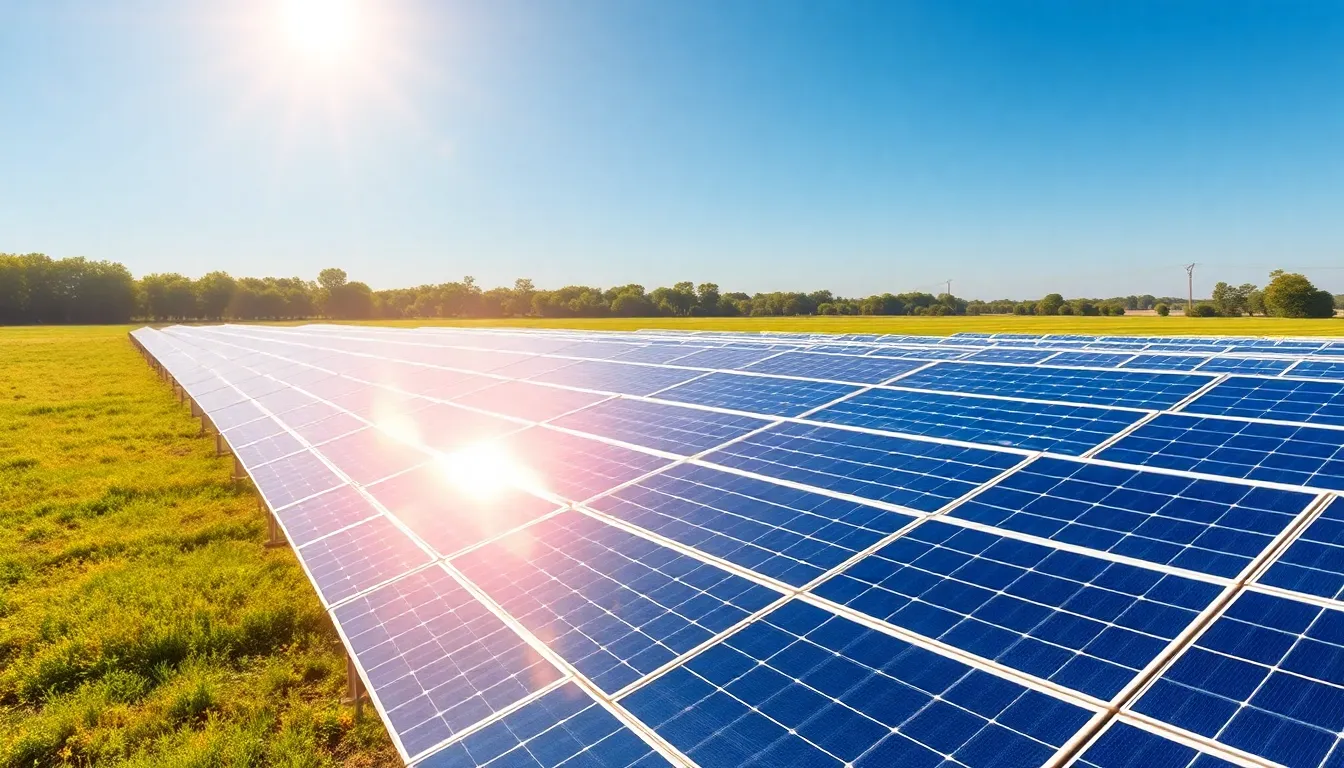Table of Contents
ToggleIn a world where the ice caps are sweating more than a marathon runner, new sustainable technology is stepping up to the plate like a superhero in eco-friendly spandex. These innovations aren’t just saving the planet; they’re making it a cooler place to live—literally and figuratively. From solar panels that double as art to biodegradable gadgets that won’t haunt landfills, the future’s looking bright and green.
Imagine a life where your gadgets are as kind to the Earth as they are to your wallet. With the latest breakthroughs in sustainable tech, it’s not just a dream anymore. This article dives into the exciting realm of eco-innovations that are transforming industries and giving Mother Nature a much-needed hug. Buckle up; it’s time to explore how technology and sustainability can dance together, leaving a lighter footprint on our beautiful planet.
Overview of New Sustainable Technology
New sustainable technology encompasses a wide range of innovations designed to reduce environmental impact. These advancements play significant roles in addressing issues like climate change, resource depletion, and pollution. Solar panels, for instance, have evolved into artistic designs that blend aesthetics with functionality, making renewable energy sources appealing.
Biodegradable gadgets represent another critical development, minimizing waste by returning to the earth naturally. Many companies now prioritize eco-friendly materials, ensuring products leave a smaller environmental footprint. Electric vehicles (EVs) stand out as transformative solutions in the transportation sector, reducing greenhouse gas emissions significantly compared to traditional gasoline-powered cars.
Hydrogen fuel cells have emerged as an alternative energy source, supporting a cleaner, sustainable future. Smart grids improve energy efficiency by optimizing electricity distribution, allowing for better resource management. Agricultural technologies such as vertical farming use less land and water while increasing food production, contributing to sustainable practices.
Waste-to-energy systems convert waste into usable energy, reducing landfill reliance while generating power. Innovations in water purification technology ensure access to clean water, essential for both human health and ecosystem balance.
These new sustainable technologies not only serve to protect the planet but also promote economic savings through efficiency and resource management. Collectively, they mark significant steps towards a future where technology and sustainability coexist harmoniously, showcasing the potential for ongoing improvement and adaptation.
Key Innovations in Sustainable Technology

New sustainable technology drives significant advancements to address environmental challenges. Innovations span various sectors, leading to cleaner, more efficient practices.
Renewable Energy Solutions
Solar energy generation has seen huge advancements through enhanced photovoltaic cells, yielding greater efficiency and durability. Wind power systems have evolved with larger turbines, capturing more energy from lower wind speeds. Geothermal energy taps into the Earth’s heat, providing consistent energy supply year-round. Battery storage technology has improved markedly, enabling better energy retention for use during peak demand times. These solutions collectively contribute to reducing reliance on fossil fuels, ultimately decreasing carbon emissions.
Waste Management Innovations
Recycling technologies have advanced greatly, with automated systems improving sorting and processing efficiency. Organic waste treatment methods convert food waste into biogas, generating renewable energy and reducing landfill impact. Innovative composting systems now integrate into urban settings, turning organic waste into useful soil amendments. Smart waste bins equipped with sensors optimize collection routes, enhancing operational efficiency. These innovations help minimize waste, promote circular economy principles, and encourage sustainable practices.
Benefits of New Sustainable Technology
New sustainable technology generates numerous advantages for both the planet and the economy. These innovations lead the way toward a more responsible future.
Environmental Impact
Sustainable technologies play a crucial role in minimizing ecological damage. Electric vehicles cut greenhouse gas emissions substantially compared to traditional combustion engines. Renewable energy sources like solar and wind reduce reliance on fossil fuels, decreasing air pollution. Innovations such as smart grids optimize energy distribution, enhancing overall efficiency. Vertical farming techniques utilize urban spaces effectively, conserving water and reducing land degradation. Biodegradable products naturally break down, lowering waste accumulation in landfills. Water purification advancements guarantee access to clean drinking water and protect aquatic ecosystems. Each of these initiatives contributes significantly to reversing environmental degradation.
Economic Advantages
Adopting sustainable technology offers considerable financial benefits. Initial investment in renewable energy often leads to long-term savings on energy costs. Enhanced energy efficiency translates into reduced utility bills for businesses and households alike. Automation in waste management decreases labor expenses while promoting recycling efforts. Green technologies foster new job creation within emerging sectors, from renewable energy to waste management. Furthermore, sustainable practices attract consumers who prioritize eco-friendly options, increasing market demand. Overall, financial incentives and savings make sustainable technology an economically viable choice.
Challenges Facing Adoption
Challenges remain for the widespread adoption of new sustainable technology. These obstacles can hinder progress toward a greener future.
Technological Barriers
Technological barriers present significant hurdles to implementation. High costs associated with developing cutting-edge solutions often limit access, especially for small businesses. Limited infrastructure can also impair the seamless integration of sustainable technologies into existing systems. Consumers may encounter a lack of understanding, which creates skepticism about benefits. Maintenance complexities can discourage organizations from adopting these innovations. Energy efficiency might be compromised without adequate training and support for users. Addressing these challenges is crucial to maximizing the potential of sustainable technology.
Policy and Regulation Issues
Policy and regulation issues affect the growth of sustainable technologies. Ambiguous regulations can slow down innovation by creating uncertainty for businesses. Governments may lack incentives for companies to adopt greener solutions. Conflicting policies at local, state, and federal levels can create confusion and hinder efforts. Limited funding for research and development restricts advancements in sustainable technologies. Collaboration among policymakers, businesses, and communities is essential to develop a favorable regulatory framework. Fostering a supportive environment increases the likelihood of successful adoption.
Future Trends in Sustainable Technology
Emerging trends in sustainable technology focus on integrating eco-friendly practices across industries. Electric vehicles (EVs) continue to gain traction, with reports indicating a projected increase in global sales to 26 million units by 2030. Renewable energy sources, such as solar and wind power, are on the rise, contributing to a global investment of over $410 billion in 2021.
Advancements in artificial intelligence (AI) optimize energy efficiency in manufacturing operations. Smart buildings equipped with AI systems can reduce energy costs by up to 30%. Vertical farming, another innovative approach, promises to revolutionize agriculture by utilizing urban spaces and reducing transportation emissions.
Blockchain technology plays a pivotal role in enhancing transparency in supply chains. By implementing blockchain, companies can track the sustainability of their products, fostering consumer trust and encouraging ethical sourcing. Biodegradable materials continue to replace traditional plastics, addressing the urgent need for waste reduction.
Tech companies are increasingly investing in carbon capture and storage solutions. These initiatives aim to mitigate greenhouse gas emissions and work towards achieving net-zero targets. Integrating sustainable practices into the internet of things (IoT) can create smarter cities, improving resource management and reducing waste.
Collaboration among stakeholders remains critical for driving innovation. Policymakers, businesses, and communities must work together to establish frameworks that support sustainable technology adoption. Public awareness campaigns educate consumers about the benefits of these technologies, driving demand for greener options.
Thus, the future of sustainable technology appears promising. With ongoing investments and innovative applications, these advancements will pave the way for a more sustainable world, balancing ecological health and economic growth.
The landscape of sustainable technology is evolving rapidly and holds immense potential for a greener future. Innovations across various sectors are not just addressing environmental issues but also enhancing economic viability. As businesses and consumers embrace these technologies the shift towards sustainability becomes more pronounced.
Collaboration among stakeholders will be key to overcoming challenges and fostering the widespread adoption of these advancements. With continued investment and a commitment to education about the benefits of sustainable practices the path forward looks bright. The journey towards a harmonious relationship between technology and the environment is just beginning and its impact will be felt for generations to come.







